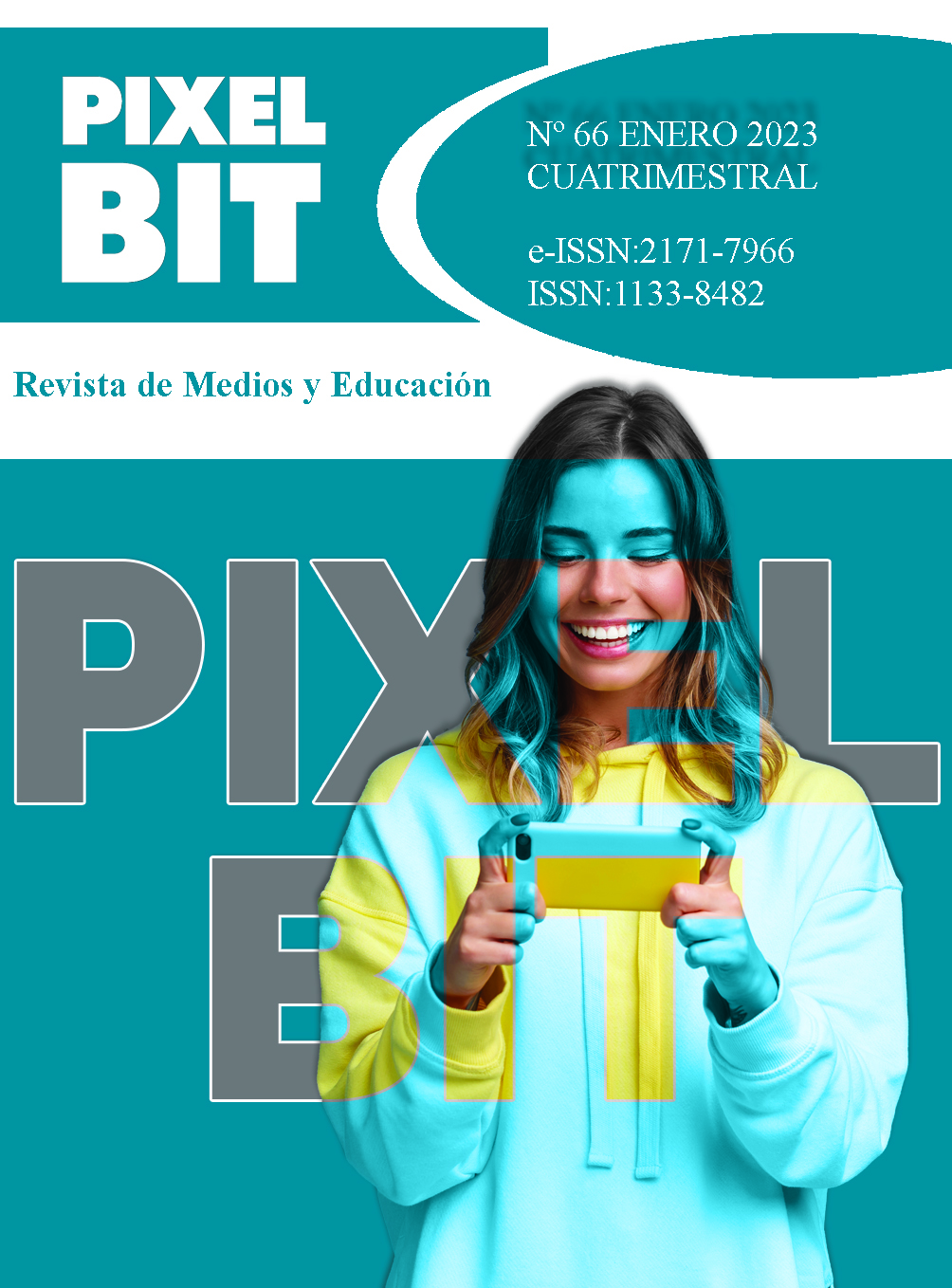Resumen
Esta investigación resalta las interacciones y procesos pedagógicos en el uso educativo de robótica y programación visual por bloques en matemáticas, en la etapa de Educación Secundaria. Partiendo de conceptos y prácticas computacionales, se integran actividades prácticas y divertidas en el aula para el aprendizaje de la unidad didáctica de coordenadas cartesianas. Los participantes son 49 estudiantes de 2º grado de Educación Secundaria, 25 como grupo experimental y 24 como grupo de control. Partiendo de diseño pre-experimental y un análisis descriptivo, la primera dimensión “Resultados académicos con el uso de la robótica” utiliza un test. En la segunda dimensión “beneficios de la robótica en contextos educativos” se valora el aprendizaje activo, los conceptos computacionales, las matemáticas, la utilidad y la diversión. Aunque se concluye que no hay mejoras significativas en el rendimiento académico, sí mejora de un modo significativo la utilidad, la aplicación en matemáticas, la utilidad percibida, y especialmente la comprensión de los conceptos computacionales.
Citas
Caci, B., Chiazzese, G., & D’Amico, A. (2013a). Robotic and virtual world programming labs to stimulate reasoning and visual-spatial abilities. Procedia-Social and Behavioral Sciences, 93, 1493–1497. https://doi.org/10.1016/j.sbspro.2013.10.070
Chen, G., Shen, J., Barth-Cohen, L., Jiang, S., Huang, X., & Eltoukhy, M. (2017). Assessing elementary students’ computational thinking in everyday reasoning and robotics programming. Computers & Education, 109, 162-175. http://dx.doi.org/10.1016/j.compedu.2017.03.001
Chevalier, M., Giang, C., Bruno, B., & Mondada, F. (2021). Teachers' perspective on fostering computational thinking through educational robotics. arXiv. https://doi.org/10.1007/978-3-030-82544-7_17
Davis, F. D., Bagozzi, R. P., & Warshaw, P. R. (1989). User acceptance of computer technology: a comparison of two theoretical models. Management Science, 35(8), 982-1003. https://doi.org/10.1287/mnsc.35.8.982
Fanchamps, N., Slangen, L., Specht, M., & Hennissen, P. (2021). The impact of SRA-programming on computational thinking in a visual oriented programming environment. Education and Information Technologies, 26(5), 6479–98. https://doi.org/10.1007/s10639-021-10578-0
Freeman, A., Adams Becker, S., Cummins, M., Davis, A., & Hall Giesinger, C. (2017). NMC/CoSN horizon report: 2017 K-12 Edition. The New Media Consortium. https://www.epiphanymgmt.com/Downloads/horizon%20report.pdf
Hair, J.F., Anderson, R.E., Tatham, R.L., & Black, W.C. (1998). Multivariate data analysis. (5th ed). Prentice Hall.
Hiltz, S. R., Coppola, N., Rotter, N., & Turoff, M. (2000). Measuring the importance of collaborative learning for the effectiveness of ALN: a multi-measure, multi-method approach. Journal of Asynchronous Learning Networks, 4(2), 103-125. https://bit.ly/3G3DzUv
Hickmott, D., Prieto-Rodríguez, E., & Holmes, K. (2018). A scoping review of studies on computational thinking in K-12 mathematics classrooms. Digital Experiences in Mathematics Education, 4, 48-69. https://doi.org/10.1007/s40751-017-0038-8
Howe, J. A. M., Ross, P. M., Johnson, K. R., Plane, F., & Inglis, R. (1982). Teaching mathematics through programming in the classroom. Computers & Education, 6(1), 85–91. https://doi.org/10.1016/0360-1315(82)90016-1
Iivari, N., Sharma, S., & Ventä-Olkkonen, L. (2020). Digital transformation of everyday life–How COVID-19 pandemic transformed the basic education of the young generation and why information management research should care? International Journal of Information Management, 55(102183), 1–6. https://doi.org/10.1016/j.ijinfomgt.2020.102183
International Society for Technology in Education and the Computer Science Teachers Association. (2011). Operational definition of computational thinking for K-12. https://bit.ly/3vpwKrw
Israel, M., Pearson, J. N., Tapia, T., Wherfel, Q. M., & Reese, G. (2015). Supporting all learners in school-wide computational thinking: A cross-case qualitative analysis. Computers and Education, 82, 263-279. https://doi.org/10.1016/j.compedu.2014.11.022
Kim, C., Kim, D., Yuan, J., Hill, R. B., Doshi, P., & Thai, C. N. (2015). Robotics to promote elementary education pre-service teachers’ STEM engagement, learning, and teaching. Computers & Education, 91, 14–31. https://doi.org/10.1016/j.compe du.2015.08.005
Kucuk, S., & Sisman, B. (2017). Behavioral patterns of elementary students and teachers in one-toone robotics instruction. Computers & Education, 111, 31–43. https://doi.org/10.1016/j.compedu.2017.04.002
Kwon, D.Y., Kim, H.S., Shim, J.K., & Lee, W.G. (2012). Algorithmic bricks: a tangible robot programming tool for elementary school students. Education, IEEE Transactions, 55(4), 474-479. http://dx.doi.org/10.1109/TE.2012.2190071
Lambert, L., & Guiffre, H. (2009). Computer science outreach in an elementary school. Journal of Computing Sciences in Colleges, 24(3), 118-124. https://bit.ly/3Q3Qdb0
Laros, F. J. M., & Steenkamp, J.-B. E. M. (2005). Emotions in consumer behavior: a hierarchical approach. Journal of Business Research, 58(10), 1437-1445. https://doi.org/10.1016/j.jbusres.2003.09.013
Luxton-Reilly, A. (2016). Learning to program is easy. Paper presented at the 2016 ACM Conference on Innovation and Technology in Computer Science Education, Arequipa, Peru. Association for Computing Machinery. New York, USA (p.p 284–289). doi: https://doi.org/10.1145/2899415.2899432
Mazzoni, E. & Benvenuti, M. (2015). A Robot-Partner for Preschool Children Learning English Using Socio-Cognitive Conflict. Educational Technology & Society, 18(4), 474–485.http://www.jstor.org/stable/jeductechsoci.18.4.474
Noss, R. & Hoyles, C. (1991). Logo and the Learning of Mathematics: Looking Back and Looking Forward. In Hoyles, C. & Noss, R. (Eds.) Learning Mathematics and Logo. MIT Press. p. 431-468
Papert, S. (1980). Mindstorms: children, computers, and powerful ideas. Basic Books. https://dl.acm.org/doi/pdf/10.5555/1095592
Rodríguez-Martínez, J.A.,González-Calero, J.A & Sáez-López, J.M. (2020). Computational thinking and mathematics using Scratch: an experiment with sixth-grade students. Interactive Learning Environments, 28(3), 316-327. https://doi.org/10.1080/10494820.2019.1612448
Sáez-López, J. M. (2017). Robots educativos y programación por bloques en Educación Infantil y Primaria: propuestas con Bee Bot y M Bot. En R. Cózar y M. V. Moya (Eds.), Entornos humanos digitalizados (pp. 35-52). Síntesis.
Sáez-López, J. M., Buceta Otero, R., y De Lara García-Cervigón, S. (2021). Introducing robotics and block programming in elementary education. RIED. Revista Iberoamericana de Educación a Distancia, 24(1), 95-113. http://dx.doi.org/10.5944/ried.24.1.27649
Sáez-López, J.M., Román-González, M. & Vázquez-Cano, E. (2016). Visual programming languages integrated across the curriculum in elementary school. A two-year case study using scratch in five schools. Computers & Education, 97, 129-141. http://dx.doi.org/10.1016/j.compedu.2016.03.003
Sáez-López, J. M. & Sevillano-García, M. L. & Vázquez-Cano, E. (2019). The effect of programming on primary school students’ mathematical and scientific understanding: educational use of mBot. Educational Technology Research and Development, 67(6), 1405-1425. https://doi.org/10.1007/s11423-019-09648-5
Spolaôr, N. & Vavassori-Benitti, F.B. (2017). Robotics applications grounded in learning theories on tertiary education: A systematic review. Computers & Education, 112, 97-107. http://dx.doi.org/10.1016/j.compedu.2017.05.001
UNESCO (2022). UNESCO ICT Competency Framework for Teachers. https://bit.ly/3WuiF85

Esta obra está bajo una licencia internacional Creative Commons Atribución-NoComercial-SinDerivadas 4.0.
Derechos de autor 2022 Pixel-Bit. Revista de Medios y Educación

